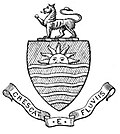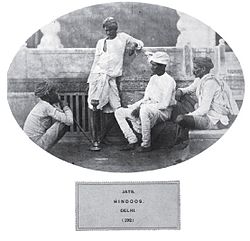Punjab Province (British India)
Punjab was a province of British India, it was one of the last areas of the Indian subcontinent to fall under British rule. With the end of British rule in 1947 the province was split between India and Pakistan. The area that made up British Punjab streched from Himachal Pradesh in the east to Khyber Pakhtunkhwa in the west, which itself was separated in 1909; has today been split into the following areas:
- Punjab Province, Pakistan
- Punjab State, India
- Haryana State, India
- Himachal Pradesh State, India
- Delhi State, India (after the Revolt of 1857)
- Chandigarh, former part of Punjab
- Islamabad Capital Territory, Pakistan
| Punjab | |||||
| British colony | |||||
| |||||
|
Coat of arms | |||||
| Map of British Punjab 1909 | |||||
| Historical era | New Imperialism | ||||
| - | Established | 1849 | |||
| - | Partition of India | 1947 | |||
| Wikisource has the text of the 1911 Encyclopædia Britannica article Punjab. |
Meaning
The word Punjab is named from the "five rivers" which flow through it: the Jhelum, Chenab, Ravi, Beas and Sutlej, all tributaries of the Indus.
Geography
The Punjab province of British India was a triangular area of country bordered by the Indus and the Sutlej rivers.[1]
Partition
In 1947, the province of Punjab was divided between the new republics of India and Pakistan. The mostly Muslim western part of the province became Pakistan's Punjab Province; the mostly Sikh and Hindu eastern part became India's Punjab state in 1966. Many Hindus and Sikhs lived in the west, and many Muslims lived in the east, and so the partition saw many people displaced and much intercommunal violence. Lahore and Amritsar were at the center of the problem, the British were not sure where to place them - make them part of India or Pakistan. The British decided to hand both cities to India, but because of a lack of control and regulation for the border, Amritsar became part of India while Lahore became part of Pakistan. Areas in west Punjab such as Lahore, Rawalpindi, Multan, Gujrat, had a large Sikh population and many of the residents were attacked or killed by radical Muslims. On the other side in East Punjab cities such as Amritsar, Ludhiana, and Gurdaspur had a majority Muslim population in which many of them were wiped out by Sikh guerrillas who launched an all out war against the Muslims.
Punjab Province (British India)Partition Media
Instrumental recording of "God Save the King" the national anthem of the United Kingdom; the same tune is also used for "Oben am jungen Rhein", the national anthem of Liechtenstein.
Map of British India, showing principal administrative divisions, London & New York, 1851. The recently conquered Punjabi territory was initially administered as part of the Bengal Presidency for a few years following annexation.






